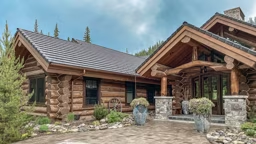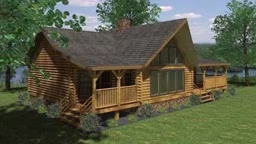
The prospect of building a custom house on a virgin piece of property is a large part of the appeal of building a log or timber home. And while most people realize and accept that they’ll need to figure out how to source electrical, water and septic services, there are other aspects to consider when you’re developing raw land. It all starts with location.
Find the Best Site on the Site
You may think that once you’ve purchased that perfect parcel, your concern with finding the ideal location is over, but it’s not. Next, you have to define the best location to place the house on that property. This where you’ll start the initial clearing, but underlying site conditions, such as the soil itself, bedrock, flood-plain issues, etc., may require some adjustments.
To determine the ideal positioning, identify a few candidates for the structure, then dig some site-testing holes, so you can see what’s below the surface. If you run into rock, for example, excavation can get expensive, depending on the type. In the South, you may find the water table may be too high in certain spots, which could cause flooding. In the North, you have to be cognizant of the frost line.
You always want to reach solid ground so you can set your home on a sound foundation. It’s hard to fight nature and win, so have some flexibility as to where your home will go.
Be In the Clear
Everyone wants to ensure their home is going to capture the best views possible. If you’re in a wooded area, you need to determine how to open up that view, what trees you’ll have to remove in the process and then clear the land far enough away from the house to achieve your desired outcome.
Many people make the mistake of simply clearing in the general location of the house, and then they start construction. Once it’s built, they realize they have branches hanging over the roof (both a fire hazard and a maintenance issue), and then they must attempt to remove them. This proves to be much more difficult to navigate than it would have been before construction started, when there were few obstacles on the site.
The rule of thumb is that if a tree could hit the house if it fell, you should clear it. Additionally, a 40-foot clearing is recommended around the perimeter of a home for forest-fire protection. You also should cut away any trees that could obstruct your driveway or interfere with power lines.
But cut with caution — removing trees can make the surrounding soil unstable because trees’ root systems help to hold dirt in place. Be sure the soil is firmly packed to protect your home and the trees you leave behind.
One final note on this subject: Take your own habits into account as well as the property’s. If you’re a morning person, consider orienting the house and clearing the tree line to allow the light of dawn to enter into your bedrooms. Conversely, if you’re a late riser and would rather enjoy a sunset than a sunrise, shield bedrooms from the sun and place your great room and a deck or porch to the west.
Manage the Moisture
Water management is one of the more significant site issues to pay attention to as you determine a spot for your house. While it’s lovely to look at a stream or pond, if it’s too close to the structure, it can affect everything from your foundation to driveway access, regardless of whether your site’s terrain is sloping or flat.
If you have water flowing freely on your property, the direction of that flow can impact your plans. Determine if there are low-lying sections of ground where water can pool. Prevent flooding by looking at which way the water naturally flows, then grade around the perimeter of your home to redirect water away from it.
For additional insurance, you could elevate the house to create positive flow around it. If you don’t, prolonged moisture exposure could cause your foundation to crack and wood to rot.
Preparing raw land to accommodate your log or timber home may sound complicated, but really it’s all about common sense. So while you’re establishing your septic field, drilling a well and tapping into electricity, taking these other considerations into account will help you save a lot of money on maintenance and repairs down the line.
Larger Lot, Lower Costs
If you’re interested in owning a log or timber home, chances are you are also planning to build that house on some acreage — often 5 to 10 acres or more. While you likely conducted a survey of the entire parcel before buying the land, you may want to order a second survey to break out a 1-acre parcel on which you will construct the actual home. There are several good reasons to do this:
- First — financing. It’s more difficult to find financing for a building on 15 acres than it is for 1 acre. Traditional mortgage options are more readily available for smaller lots (typically less than 3 acres), while specialty lenders, such as Farm Credit, handle developing large tracts of land. By having a surveyor cordon off a smaller section of your property for development, only that section needs to be part of your loan application.
- Second — insurance. Insuring 14 acres of vacant, unspoiled land and 1 acre that’s developed with a dwelling is much less expensive than insuring 15 acres with a house on it.
- Third — taxes. The taxation rate is higher for developed property than raw property, so by developing a smaller plot, you can save a considerable amount of money on taxes.
- Fourth — resale. In the future, if you find you want to sell off some of that acreage, it’s already separated from your home site, so you won’t have to deal with that red tape later on.
Follow these tried-and-true tips and you will get to own that pastoral property, but you won’t have to pay through the nose for it.
Dan Mitchell is a builder and a log and timber home educator. He owns Eagle CDI, a construction and development firm based near Knoxville, Tennessee.








_11868_2024-09-17_08-44-256x288.avif)


